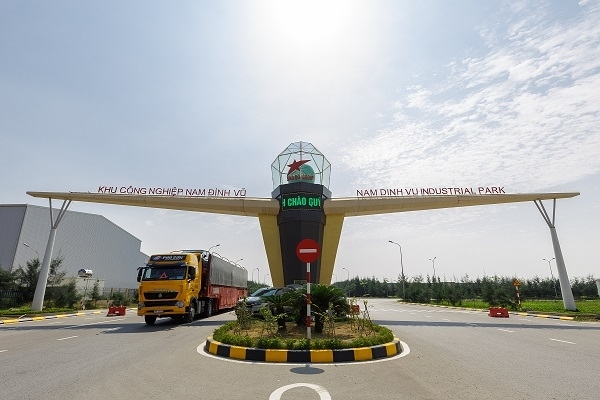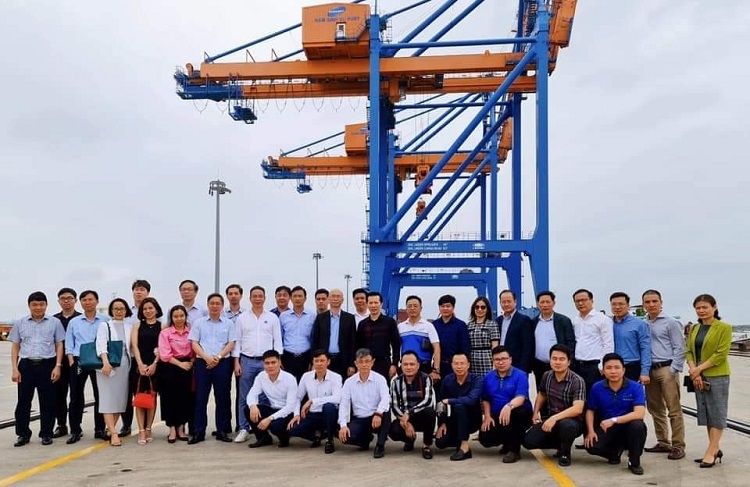The development of industrial zone attached with seaport boost investment efficiency
 |
| Nguyen Thanh Phuong, General Director of Sao Do Group |
Nam Dinh Vu Industrial Park (IP) owned by Sao Do Group is one of the large-scale IPs of Haiphong city. So, what strong points does the attraction of Nam Dinh Vu IP come from?
With a total area of 1,329 hectares, Nam Dinh Vu IP is divided into four functional subzones: seaport and logistics zone, oil and gas zone, industrial production zone, and a duty-free zone.
When making the plans for Nam Dinh Vu IP, we were looking to build an integrated IP with functional subzones forming a complementary ecosystem. The output of this enterprise could be input for others. In particular, the nearly 200ha seaport and logistics subzone, which is equipped with seven container and general cargo berths, is the focal point for this strategy. The infrastructure of bonded and logistics warehouse areas has been invested following modern and synchronous standards. These are the main features of Nam Dinh Vu IP.
Currently, the technical infrastructure of the first phase of Nam Dinh Vu container port is complete, with two berths being put into operation with a capacity of about 800,000 to 1 million TEUs per year. The next two berths of the second phase are under investment, to be completed and exploited by mid-2022, tentatively. All equipment are newly purchased, modern, and in line with international seaport operation standards.
We also invested in 13ha of bonded warehouse space that is currently in effective exploitation. It has been gradually contributing to the completion of facilities and services in the area.
 |
| Sao Do Group's Nam Dinh Vu IP is one of the few IPs in Haiphong that has developed its infrastructure in association with a seaport |
Seeing that Sao Do Group has made huge investments in logistics infrastructure when building Nam Dinh Vu IP, how would you assess the potential of logistics industry development in Haiphong?
Haiphong has the advantage of not only being a big city directly under central government but also being a growth pole in the key economic triangle of the northern region, while also possessing convenient seaport and logistics systems which have been exploited effectively for hundreds of years.
In recent years, the transport and logistics infrastructure of Haiphong (seaports, airport, railway, roads, warehouses, among others) have received strong investments. Haiphong is also a major logistics centre of the north which has created its own characteristics and advantages in industrial real estate growth of the city, which is the development of industrial zones (IZs) infrastructure linking closely with seaport operation. Based on that factor, we determined that Nam Dinh Vu IP would be an integrated zone attached with seaports and logistics.
Besides that, Resolution No.45/NQ-TW of the Politbureau set the direction for Haiphong to become a modern industrial center to support logistics in the region and the country. This has been encouraging the local government to turn the city into a regional and international logistics service centre, creating tremendous development opportunities to the enterprises operating in this field.
The growth rate of Haiphong's logistics industry is forecast to increase rapidly. Specifically, according to the adjusted master plan on socio-economic development of Haiphong city to 2025, with a vision to 2030, the average growth rate of logistics services in 2021-2025 will be 16-18 per cent per year and 17 per cent in 2026-2030. Thus, it can be said that the companies operating in logistics or related fields are also having favourable growth opportunities.
 |
| The delegation of the Ministry of Industry and Trade, and logistics enterprises paid a working visit to Nam Dinh Vu Industrial Park |
From your point of view, is it easy to seize these opportunities?
Haiphong is the trading gateway of the northern region and the whole country, connecting to all countries over the world. Haiphong, with 125km of coastline, more than 400km of inland waterways, and five major estuaries (Bach Dang, Cua Cam, Lach Tray, Van Uc, and Thai Binh River), has great potential for socio-economic development. Its seaport system has the largest throughput in the north and is ranked second in the country (after Ho Chi Minh City). In addition, Haiphong owned many ports with a modern equipment system as well as adequate and safe infrastructure capable of accommodating international and commercial means of transport.
However, even possessing such favorable location and potential, Haiphong has not fully brought into play these advantages yet. The city’s logistics activities are mainly focused on the transportation and loading/unloading of goods from ports – the stages that create the least added value in the logistics service supply chain.
In fact, road transportation services are provided by hundreds of companies. Most of them are small- and medium-sized, causing many problems such as unfair competition and ineffective exploitation. Shipping costs are still high due to inadequate transport management (mainly by road, mostly one-way vehicles), delivery method, cumbersome administrative procedures, and the low quality of warehouse services. As gathering and returning goods as well as completing procedures still takes a long time, costs remain high.
Above are the difficulties Sao Do is facing when developing a logistics area in Nam Dinh Vu Industrial Park. To solve this general issue, in my opinion, Haiphong city needs to synchronously invest in infrastructure outside the fence of industrial zones in a modern direction, attract large enterprises in the logistics sector, accelerate the administrative reforms and support all businesses. It also needs to pay attention to attracting and training human resources operating in the field of logistics.
Furthermore, it is indispensable to set up specific policies for a new, modern logistics centre to encourage logistics activities such as site clearance, land rental exemption and reduction for the construction and investment of logistics centre infrastructure, as well as import tax reduction for machinery and equipment that cannot be produced domestically to serve the operation of logistics centers.
What the stars mean:
★ Poor ★ ★ Promising ★★★ Good ★★★★ Very good ★★★★★ Exceptional
Related Contents
Latest News
More News
- Haiphong breaks ground on landmark industrial park and LNG power plant (September 28, 2025 | 09:00)
- DEEP C partners with Signify to develop green lighting in industrial zones (August 27, 2025 | 11:01)
- Nam Dinh Vu Industrial Park taps new free trade zone to attract high-quality investment (July 29, 2025 | 14:41)
- Haiphong attracts $15.6 billion in investment (July 16, 2025 | 13:49)
- KinderWorld opens Singapore International School in Haiphong (May 13, 2025 | 14:20)
- Red Flamboyant Festival connecting milestones with ambition (May 13, 2025 | 10:08)
- Haiphong restates its goals with solid fundamentals (May 13, 2025 | 09:57)
- Heroic Haiphong stands tall (May 13, 2025 | 09:38)
- Haiphong’s thrust to go green and digital (May 13, 2025 | 08:00)
- Haiphong private sector emerges as key engine of economic growth (April 21, 2025 | 11:44)

 Tag:
Tag:




















 Mobile Version
Mobile Version